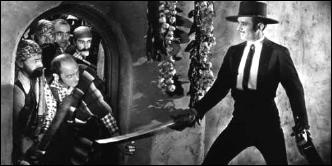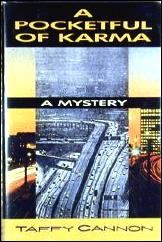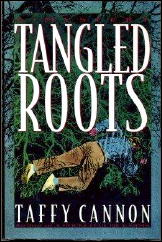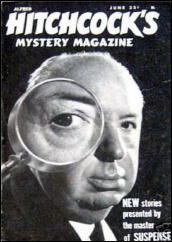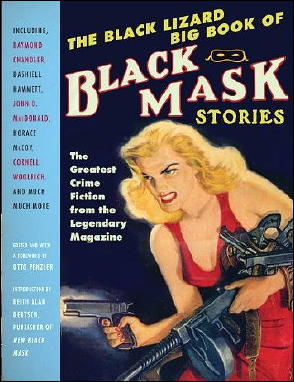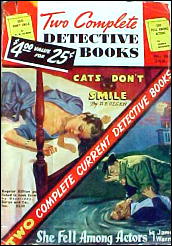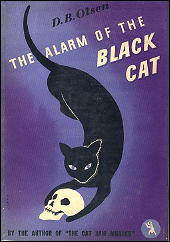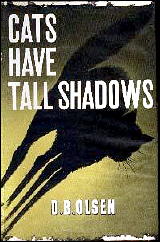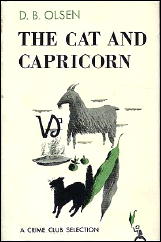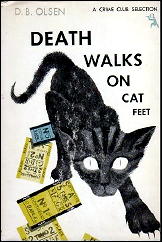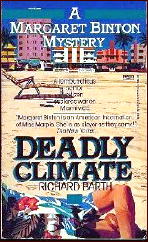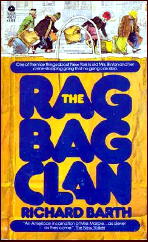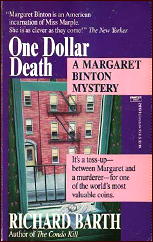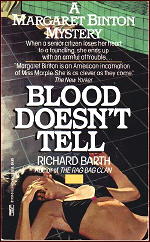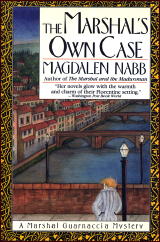COLLECTING PULPS: A MEMOIR
PART ONE — BLACK MASK
by Walker Martin
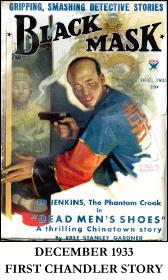
In the 1940’s an admirer of Raymond Chandler’s fiction wrote a letter asking Chandler if it was possible to obtain back issues of the magazines containing his stories. Chandler responded that it was just about impossible to find such back issues and he doubted if the correspondent would have any luck.
Jump ahead more than 20 years to 1968 and that was my attitude also. I had been a SF fan for over 10 years collecting the pulps and digests, attending the SF conventions and reading the fanzines.
Since I also was reading a lot of mainstream literature and mystery fiction, I was interested in back issue magazines that published fiction other than SF, but I was not finding the issues.
I figured the SF and hero pulps survived because of teen age boys and their drive to collect things. So I reasoned that the adults must have read and thrown away their copies of the adult pulps like Black Mask, Adventure, Dime Detective, Short Stories, etc.
However, in 1968 a life changing event occurred and I know we all laugh when we hear those words because often it is not really THAT “life changing”. But it was in my case and I never really realized the impact of simply buying one paperback until decades later when I was almost crushed by a collapsing, heavily loaded bookcase full of detective pulps.

As I lay there too stunned to move, I began the process of thinking how had my reasonable SF collection turned into a massive amount of pulps, vintage paperbacks, books, etc.
The event I’m talking about is the mundane task of buying a book titled The Hardboiled Dicks, edited by Ron Goulart. It was a collection of crime stories from such pulps as Black Mask, Dime Detective, Detective Fiction Weekly. After reading the stories and Goulart’s editorial comments, I realized without a doubt, it was possible to collect the detective pulps and the genres such as western and adventure fiction.
I wrote Goulart and asked him if it was possible to buy his copies of the detective magazines that he had used for his research. I’m happy to say he wrote back and sold me all the copies he had for only a couple bucks each.
These few pulps that he sold me eventually caused me to accumulate complete sets of Black Mask and Dime Detective and an almost complete set of Detective Fiction Weekly, not to mention the other titles that I started to also collect. Almost 40 years later Ron Goulart wrote in my copy of The Hardboiled Dicks, “For Walker, whose life I ruined”.
“Whose life I ruined” just about sums up the thoughts and feelings of many non-collectors when they see a house full of books and old magazines. I could give dozens of examples but I’ll try and control myself and just mention one early story from 1969 involving collectors, non-collectors, and romance.
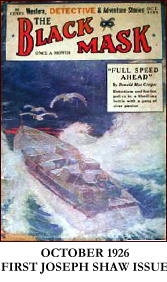
At the time I was busy writing hundreds of letters to collectors, book stores, etc. in an attempt to put together complete sets of Black Mask and the other detective magazines. This was pre-Pulpcon and the Internet did not exist, so everything was by regular slow mail.
The Collector’s Bookstore in California sent me a package of about a dozen Black Mask’s from the thirties. Needless to say I was checking my mail every day but the day they came I was at work and the package was returned to the main post office. I showed up early the next morning before work with the postal slip saying there had been a failed attempt to deliver.
The Trenton NJ post office was a massive structure and the postal clerk returned after a few minutes and told me he could not find the package. The next few minutes are still a blur in my memory, but let’s just say the head postal inspector was summoned and he tried to calm me down by saying there was nothing to worry about since the package was insured.
I imagine every fellow collector reading this knows my response along the lines of “I didn’t care about the insurance, the magazines were rare collectables and irreplaceable.”
After another long delay and search they found the stack of Black Mask’s with just some twine wrapped around them and no package left at all.
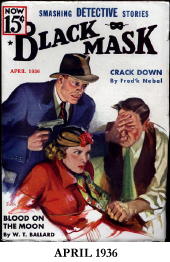
When I arrived at work I was completely frazzled and shaken. The employees I worked with could not understand why I was so upset about some old crumbly magazines.
After I regained control, I showed the stack to a girl I was interested in who had the desk behind me. I told her about the importance of Raymond Chandler and Dashiell Hammett and even asked her if she would like to read any of the magazines.
Her response of “no” was a deal breaker and the end of any possible romance. I never did have any luck in finding a woman who liked pulps.
So began my lonely occupation of collecting back issues. The great number of letters I was mailing resulted in many collectors across the country selling me Black Mask’s . Richard Minter, who was the greatest mail order pulp dealer who ever lived, was especially helpful.
At first he was surprised because all his customers were mainly SF and hero pulp collectors. He had no one interested in the detective magazines. But because of his extensive contacts among old time collectors, he started mailing me a steady stream of packages, all wrapped in brown paper with string and old stamps that someone must have paid him with.
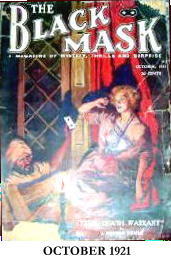
I know this is hard to believe but he was asking only 2 or 3 dollars per pulp. This was the average price I was paying and the set was almost completed except for a very few issues.
My main activity during 1969,1970, and 1971 revolved around finding back issues of Black Mask. I cared nothing for my work career, it was just a means to be able to collect. By the first Pulpcon in 1972 I had a complete set of the 340 issues except I was lacking one hard to find issue, October 1921. Some of the issues were in rough shape, and for many years I continued to upgrade.
At first, I had no real competition but as I started to rave to other collectors, my enthusiasm created the market and other people started to pick up issues. There was a fellow collector in Trenton who I kept talking to about how great the magazine was, and before I realized my stupidity, he was my main competitor.
We both eventually ended up with complete sets and as far as I know there were only a couple other extensive runs, including one at UCLA, but nothing complete.
At the end, in order to beat out the competition, I was sending dealers more than they asked for because I figured they would sell to me even if another collector beat me to the item. Many a time, someone would ask $5 for example and I send them double the amount, with my comment of “I feel the issue is worth more”. It always seemed to work.
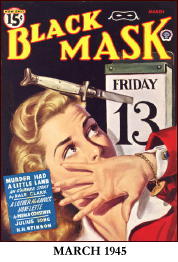
Concerning the October 1921 issue, there must have been something wrong with print run of that date or perhaps many copies were destroyed in some accident, etc.
I say this because out of 340 issues, 1920-1951, the two collectors with almost complete sets both needed this same issue. For many years I advertised and hunted for it and finally dealer Jack Deveny, at an early eighties Pulpcon, conducted a mini auction between me and several collectors. There was no way I was not going to get the issue and my sealed bid won at over $700. Back then, this was an unheard amount to pay.
Eventually, I tracked down three original Black Mask cover paintings, all from the 1940’s. One of them I managed to get from artist Raphael Desoto after a weekend of talking to him at an early book convention. I cried, I whined, I begged, etc. Nothing is too shameful among serious, out of control collectors.
I also manage to find a stack of canceled checks paying Black Mask writers and artists. When I bought them back in the 1970’s no one would even pay $1.00 each. Now they bring far higher amounts.
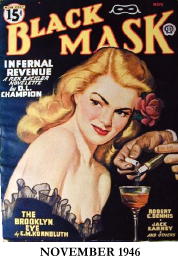
After Black Mask died in 1951, Ellery Queen Mystery Magazine bought the title and beginning with May 1953 issue had a section in each issue reprinting two stories from the magazine. Eventually they cut back to one story and even published new stories in the Black Mask tradition.
They soon added the subtitle “including Black Mask Magazine” on the contents page. This subtitled continued off and on through the fifties and sixties and I see it appearing even as late as the September, 1973 date.
I’ve done extensive reading in the magazine during almost four decades. The twenties are not that readable, except for Dashiell Hammett, Frederick Nebel, Raoul Whitfield and Erle Stanley Gardner. Some readers even like Carroll John Daly.
By the time Joe Shaw took over in late 1926, things began to improve and he encouraged the above writers. Most readers find the thirties the best and even some collectors present an argument for the 1940’s when Popular Publications took over with Ken White as the editor.
Behind Hammett and Chandler, I think Paul Cain was the best writer even though he was not that prolific, then Nebel, Whitfield, and Norbert Davis. The 1940’s are full of excellent writers like Merle Constiner, John D. Macdonald, Robert Reeves, D. L. Champion, Cornell Woolrich, William Campbell Gault, and others.
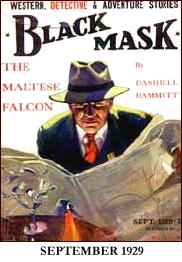
To collect the magazine nowadays would require a lot of money and I’m not even sure a set could be put together. Hammett and Chandler issues are expensive, going for hundreds of dollars each. I recently saw the 5 issue “Maltese Falcon” issues go for almost $4000 and I thought this price was too low.
Even without these two authors in the issue the 20’s and 30’s go for over one or two hundred, according to condition. The forties still are affordable with plenty of readable stories and it’s possible to find issues at the $25 to $50 price.
Fortunately for readers who want to sample the fiction there are several collections:
The Hard-Boiled Omnibus, edited by Joseph Shaw
The Hardboiled Dicks, edited by Ron Goulart
The Hard-Boiled Detective: Stories from Black Mask Magazine, edited by Herbert Ruhm
The Back Mask Boys, edited by William Nolan
The Black Lizard Big Books of Pulps edited by Otto Penzler (most of the stories).
The Black Lizard Big Book of Black Mask Stories, edited by Otto Penzler (over 50 stories!)
Thus ends my story of a 40 year love affair with a pulp. I can truthfully say I have only learned two things in life, “The non-collector will never understand the collector.” And “Never take the advice of a non-collector concerning your collection.”
These two things are absolutely true and you might ask why? Because the non-collector knows absolutely nothing about your collection and just sees it as so much clutter, waste of money, and a crazy waste of time. But we know different, don’t we.
COMING SOON: Part Two — Collecting Dime Detective.

